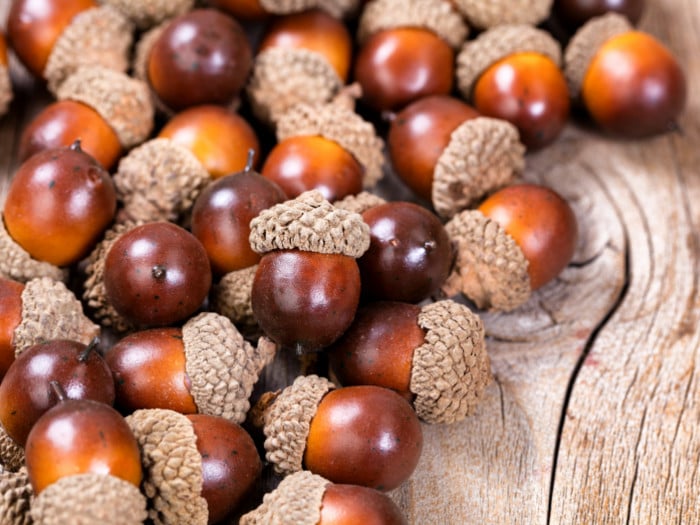If you have ever asked yourself – are acorns edible? – then it’s a good idea to get a clear picture of the risks and potential benefits of eating acorns.
Are Acorns Edible?
Acorns are the nut of oak tree species and are typically encased in a hard leather shell, containing a single seed. While most people dismiss acorns as food, due to their extremely hard exterior, they are completely edible and have long been an important source of nutrients in human cultures. Dating back thousands of years, the abundant acorns of North American forests were once a staple food and remained prominent well into the 20th century in some parts of the world.
Acorns are high in certain essential nutrients, particularly fats and carbohydrates, which is what makes them so desirable as food, especially if you ever find yourself lost in the wild. In terms of the fattiest acorns, Eastern red oak acorns are extremely oily, but all varieties have a relatively high level of natural oils. If you are looking for a sweet acorn, the closest you will likely find is European cork oak acorns. [1]
The most popular acorn varieties and those with the highest density of nutrients include green acorns, red oak acorns, and white oak acorns. [2]

Acorns are a great source of fiber used for herbal remedies to treat stomach pain. Photo Credit: Shutterstock
Nutrition Facts of Acorns
While every species of acorn will be slightly different in terms of nutritional profile, the majority of acorns have a composition high in carbohydrates, fat, and water. When it comes to the fat content, the vast majority is in the form of monounsaturated fats, along with some polyunsaturated fat and the smallest amount of saturated fat. There are also minerals found in acorns, such as potassium, iron, calcium, and magnesium, in addition to B vitamins and protein. [3] [4]
Leaching Acorns
If you do want to eat acorns, there are a few methods to make them palatable. The process to make acorns edible is called leaching, and it can be done with either hot or cold water. To begin with, however, you need to shell the acorns. The easiest way to do this is to freeze the walnuts after collecting/harvesting, which will kill any weevil larvae that may be present. Then, dehydrate your acorns for 2-3 hours until they are nice and dry. At this point, it will be easier to crack open the acorns and remove the hard outer shell. [5]
The process of leaching is done to remove some of the tannins from the acorn, which will eliminate some of the bitter flavors, making them much more pleasant to eat. [6]
Hot Water Leaching
Hot water leaching is a rapid process, but it doesn’t result in as high-quality of an acorn, nor will the resulting flour be as effective, if your intention is to make a nutrient-dense flour with the nuts. However, hot leaching can be done relatively quickly.
- Step 1: Fill a pot with the acorns you wish to leach, filling no more than 1/3 of the pot.
- Step 2: Pour water into the pot to the 2/3 mark and bring to a boil.
- Step 3: The water will turn brown as the acorns are boiled.
- Step 4: Dump the water and re-fill the pot with fresh water.
- Step 5: Repeat the boiling and dumping process at least 3-4 times, until the bitterness is removed from the acorns.
- Step 6: In some acorns, this can take 8-10 rounds of boiling.
Cold Water Leaching
While cold water leaching requires a bit more effort, experts and those who cook often with these nuts say that this is how to get the highest-quality acorns for cooking. If you are planning to use the nuts and grind them into a flour, the cold leaching approach is the best. There are two main approaches to cold water leaching – one using a toilet tank, and the other using a jar. [7]
Toilet Tank
- Step 1: Empty the back of your toilet tank and scrub it thoroughly.
- Step 2: Add the shelled acorns to a cheesecloth and tie it.
- Step 3: Hang the acorns bag in the toilet tank so it is submerged when the tank fills up.
- Step 4: Each time the tank fills and flushes, it will leach more and more of the tannins from the nuts.
- Step 5: This could take days or weeks, depending on how often you use your toilet.
Jar Method
- Step 1: You will need to grind the acorns into powder using a hand mill or food processor.
- Step 2: Add the powdered acorns into a large sealable jar.
- Step 3: Fill the jar the rest of the way with tap water.
- Step 4: Shake the jar and place in the refrigerator.
- Step 5: Wait 24 hours and then slowly pour out the tannin-filled water.
- Step 6: Repeat this process 3-4 times, then taste the acorn meal.
- Step 7: Some overly bitter acorns will require 6-7 rounds of this process.
